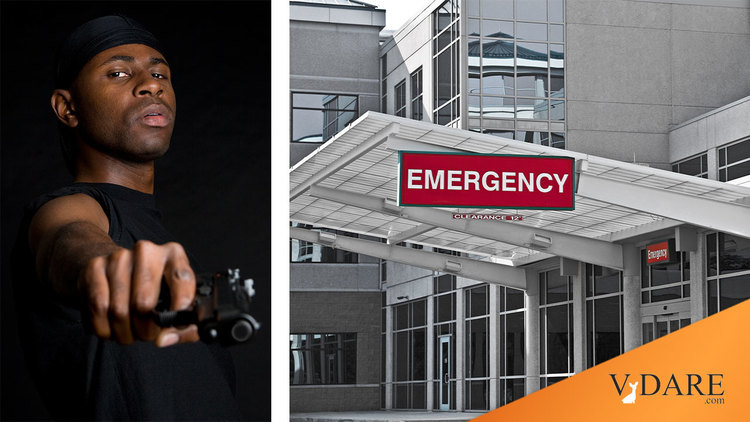Earlier: Mr. President, We Must Close the Gunshot Gap!
![]()
So, the second half of 2019 was shootier than the second half of 2018, which was likely the least homicidal year nationally since BLM emerged at Ferguson. The first two months of the pandemic, March and April 2020, were pretty ho-hum at around 30 medical care–requiring shooting incidents per million, but then went up to c. 35 in May and c. 45 in June and shootings stayed very high until the weather cooled off after the election. But in 2021, June was even worse than June 2020.
It would be interesting to see data by week for May 2020 to see whether blacks didn’t get so much more shooty until the last week of the month after the death of George Floyd, or whether the trend took off earlier in the month, perhaps due to all the media agitation over Ahmaud Arbery?
From Epic Health Research Network:
2020 Firearm Injuries Up More Than 70%–Worse in Black and Hispanic Young Men
Abstract: Healthcare visits for firearm injuries increased significantly for all patients in 2020, particularly for non-White populations.
15 Sep 2021
Dual Team Study
Team A: Ryan Bohochik | Lindsay Lin, PhD | Eric Lindgren, JD
Team B: Johnston Thayer, RN | Adrianna Teriakidis, PhD
These data come from Cosmos, a HIPAA-Limited Data Set of more than 118 million patients from 136 Epic organizations including 705 hospitals and 12,172 clinics, serving patients in all 50 states.
That’s not a bad sample size. Epic is the giant software firm that provides a larger percentage of the software used by doctors these days.
This study was completed by two teams, comprised of clinicians and data scientists, that independently acquired and analyzed data. Both teams were involved in the interpretation of results and drafting of this brief. Overall, the two teams came to similar conclusions.
… We reviewed EHR data for patients who sought care for at least one new firearm incident. The data show a sharp increase in incidents starting in late spring 2020, with monthly incidents peaking in October 2020 at 73% higher than the monthly average in 2018 and 2019.
Firearm incidents increased for patients of all races and ages, as shown in Figure 2 and Figure 3 below, but the increase was not proportional across races. To smooth month-to-month variation, we calculated 5-month rolling averages and found that incidents increased for non-White populations by between 76% and 89% while they increased for the White population by 40%.
![]()
Five month rolling average of the percent change in firearm incidents from March 2018 to April 2021 above or below the baseline historical average from January 2018 to December 2019, stratified by race or ethnicity. The “Other” category includes any race or ethnicity outside of Hispanic, Black, or White.
… We further stratified new firearm incidents by race or ethnicity and age, as shown in Figure 3. Black male patients ages 18-34 have historically had more firearm incidents than patients from other groups. Black female patients ages 18-34 have also had more firearm incidents than other female groups.
![]()
At a time when other interactions with the healthcare system decreased, visits for new firearm incidents increased, particularly for non-White patients.
A lot of important people have a lot of blood on their hands from promoting Black Lives Murdered.
[Comment at Unz.com]
















